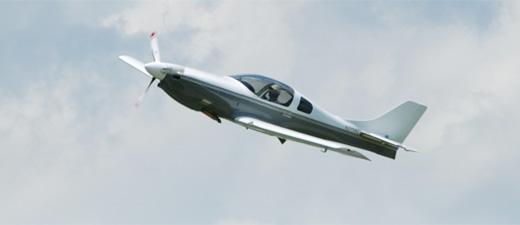
My motto is: Everything can be improved. Which explains the changes I made to my Lancair 235. Our little flying Ferrari is not the fastest of its brothers, true. It has look-alikes with larger engines that are 10 to 15 knots faster, and many are prettier—but not much. Regardless, we really smile a lot going fast, but cautiously, as Lancair speed comes with caveats. This I discovered when we got serious about buying this speedball project, which was incomplete. But back to my motto: Everything can be improved, so we bought it and I did some mods, a lot of mods!
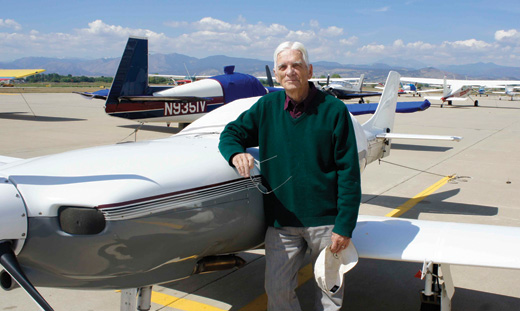
The author enjoying repose at Longmont, Colorado, after 4.7 hours (flying time) from Greenville, Illinois. He flew some 734 n.m., using 7.2 gph, at 23.5 in. and 2330 rpm, at 4500 and 6500 feet. He says he should be able to go higher, faster and use less fuel. Cowl flaps would help, as CHTs run less than 300° F, which means too much cooling drag.
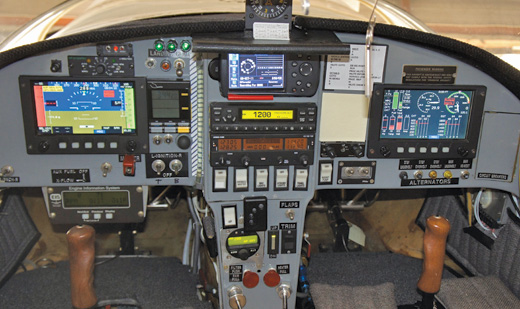
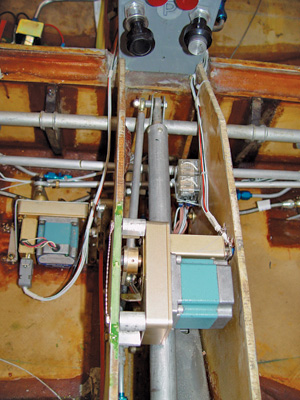
Backing up a bit, my wife and I had sold our 125-knot Dragonfly and stepped up to the Lancair so we could go faster and farther to visit our kids, who are scattered around North America. Last time we looked, only one of our six lived nearby in Illinois. Two were in the Boulder, Colorado, area, one in Reno, one in Claremont, California, and one in Prince George, British Columbia. That’s pretty far for them to come to visit us, but we’re retired and are freer to travel to them.
Making the Trip
Thankfully, our two-seat Lancair gives us options. If you follow homebuilts carefully, you probably already know the genealogy of the side-by-side Lancairs. Lance Neibauer started with the Lancair 200, which soon grew into the 235 with a change from the Continental O-200 to the Lycoming O-235. Soon the 320 and 360 came along with more power—150 horsepower and 180, respectively—and next Lancair got into the four-seat category in a big way with the IV, IV-P and IV-P turbine. Today, the company makes the Evolution in turbine and piston form, and a close relative of the 320/360 called the Legacy that has little more than shape in common with the early two-seaters.
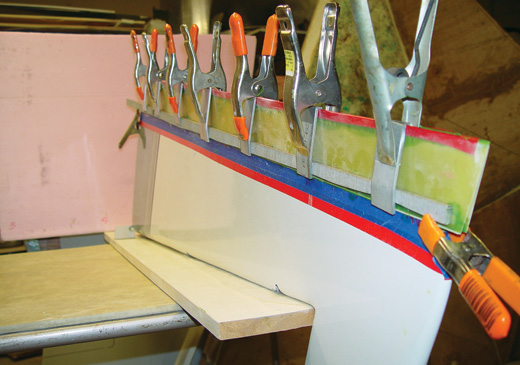
The rudder area being increased (the first time). Just a 2° inadvertent cusp produced huge rudder untrim at 150 knots and had to be redone. Tabs are powerful.
About 450 of the 235s/320s are flying, all with similar airframes. In 2009 there were six 200s, 104 of the more powerful 235s, 218 of the 320s (yet more power and a little wider seating) and 133 of the (even more power) 360s. These model numbers are a little confusing because they refer to the model by the engine size originally selected for that airframe—but that’s not necessarily the engine that builders put in their airplanes. Take ours as an example: It’s a 235 airframe, but when we found our project it already had a 160-hp Lycoming O-320 hanging on it. I then converted the engine to fuel injection—mainly so I could run it at lean-of-peak EGT settings for better fuel economy.
I had some help from the experienced owners on the Lancair Mailing List. These Lancair guys are “go-fast” types, so they often improve the power or slick the aerodynamics, and they help each other do the same via the Internet.
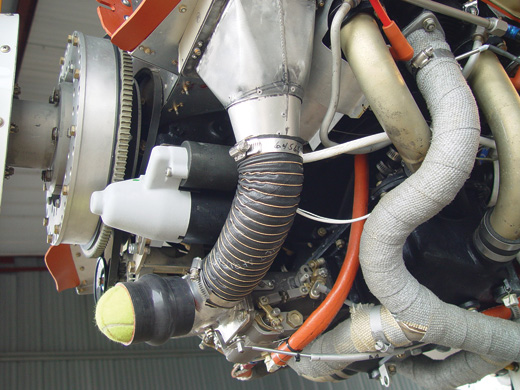
The ram or filtered airbox bolted to the injector servo gives almost an inch of additional manifold pressure above 8000 feet for a little more speed. The torsion damper on the starter flywheel was removed when the author changed from a fixed-pitch wood to an electric MT prop.
Lancair Basics
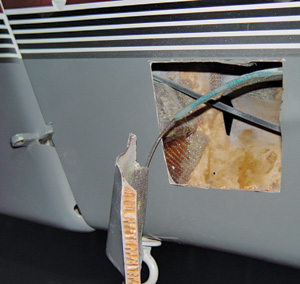
The access panel for the anti-servo had to be cut out (carefully) ahead of the rudder to mount the actuator underneath the stabilizer.
To understand the reasoning behind my modifications, it helps to know a few things about two-seat Lancairs. First of all, these airplanes have a reputation for being fast and somewhat tricky. Part of this characteristic is attributable to wing loading. At 25 pounds per square foot of wing, the Lancair 235/360 is well into high-performance, single-engine land; a Mooney’s wing load is 19 psf, and a Bonanza’s slightly more. This tells us the Lancair flies a bit hotter, and with less wing it also lands faster.
Next is power loading, where the Lancair once again beats the production models. With just 10 pounds of airframe to lift for every horsepower, the Lancair is overpowered compared to Mooneys and Bonanzas (both about 12 pounds/hp). These numbers generally indicate speed and rate of climb for a modest 20% Lancair power/speed advantage. But the 20% is conservatively misleading because of a few important considerations. One is composite construction, which reduces the drag coefficient and frees more horsepower for performance. The little Lancairs are smooth and fair, and because they have less overall drag, the effective available horsepower-to-weight ratio is better.
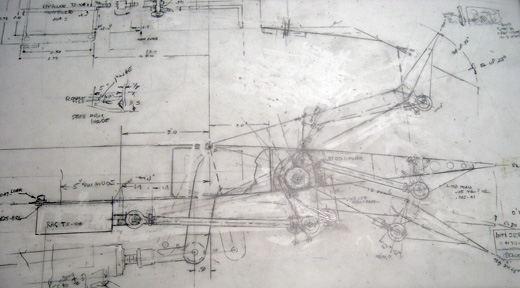
The anti-servo trim actuator system was designed to complement the original elevator system and replace the original spring trim assembly.
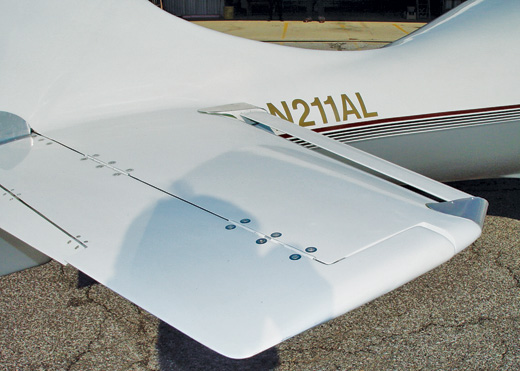
Slots and tabs are unique. The slat floats up or down, hitting a stop when the stabilizer is near its stall angle. Then it works to delay tail stall for about 10° AOA to ensure pitch unstalling power. The tab can trim the elevator, and it also increases stick resistance per G.
Another speed secret is that the Lancair’s wing airfoil is a newer, natural laminar flow section designed from the get-go to give even lower drag through a wider speed range by reflexing the trailing edge in cruise flight—in the flap section only. This extends the wing’s low-drag laminar flow, but it also has another, often unnoticed, effect: Reflexing the flap moves the center of the wing’s lift forward and closer to the center of gravity, effectively reducing the horizontal tail’s balancing load and the related tail drag.
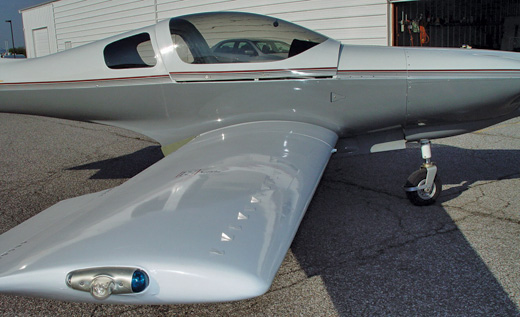
The author installed vortex generators, and claims that the airplane just mushes at the stall angle of attack.
The Lancair differs from certified aircraft in many ways, including handling, which has been described as “twitchy” by those without a lot of experience in the airplane, as well as “delightful” by military- and airline-trained pilots who seem to gravitate to the design. Example? Take landing speeds, which are higher than those for slower-stalling conventional airplanes and demand attention. I usually fly an approach at 85 to 90 knots, and slow to 75 to 80 on final, making the touchdown maybe 5 knots slower. A little fast, but it’s on a nice, wide trigear. You hit, and it sticks.
Pitch Control
These airplanes have been tested many times by pros—CAFE Foundation, ex-military instructors, test pilots and top guns. Studying their reports, I raised an eyebrow when the testing revealed pretty light pitch forces, with low control force-per-G compared to Standard Category designs. Was this issue possibly involved in some accidents?
I had also read that this light pitch control characteristic resulted in Australian authorities requiring Lancair to remedy what the Down Under regulation guys thought was a problem—slow stall recovery. Lancair chose to enlarge the original small horizontal tail on the 320 and later versions. Judging by comments from some Lancair pilots who were already flying theirs, they just take extra care not to stall, especially at low altitude, though others commented that their aircraft recover from a stall normally.
After reading tests by professional test pilots, I decided to simply eliminate this problem by adding slots to our already-built small horizontal tail. These slots are intended to keep the horizontal tail from stalling for about 10° to 15° higher angle of attack than the wing’s stall AOA, so now there seems to be plenty of “un-stall” power back there.
I also installed my own “bacon saver” AOA indicator. I mark my AOA at the wing’s stall angle and also at the AOA I use for approach. This takes the worry out of steep turns at low altitude, or on hot-day takeoffs at gross or in turbulence. The indicator is positioned on the left wing, right in my field of vision during landing. I’ve used these on each of my airplanes for more than 35 years. I don’t care if it looks tacky; it makes slow flight no sweat.
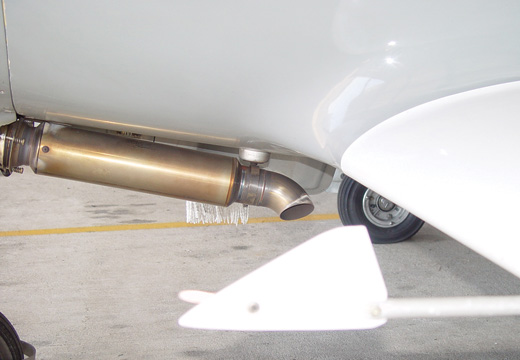
A Burns Stainless muffler captures most of the noise coming out of the “straight pipes” no-collector, double two-into-one exhaust stacks 3 feet below people’s ears.
Another pitch-related safety mod I made is to the Lancair’s standard pitch-trim system—a manually cranked spring device attached to the elevator pushrod. It bothered me because I don’t like springs on control surfaces, where free movement is critical to flutter. So I took it out and designed an irreversible electric anti-servo trimmer (irreversible in the sense that the controls can’t drive the servo; when it’s not in motion, it’s locked). I hoped it would also increase the elevator power and “heavy up” the pitch control. I haven’t read any other pilots’ complaints about the original trimmer, so probably it wasn’t really necessary, but it works fine and I eliminated a worry. [Editor’s Note: Adding trimtabs or any aerodynamic device to a mature design should be undertaken with extreme care and followed by a thorough flight-test program to validate the results. Aircraft have been lost from fluttering trimtabs.]
Another complaint I picked up on from the Lancair Builders’ comments was the sharp stall characteristic that some builders found, though others did not. I adopted a cure that one Lancair flier had already developed: vortex generators ahead of the ailerons. Now my Lancair just mushes at the stall AOA.
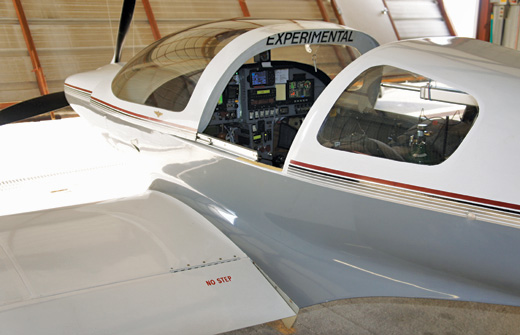
Electrically actuated, the canopy is removable with four quick-release pins and one pin through the actuator shaft.
Canopy Update
The original bubble canopy opening system is a wobbly trapezoid thing that I lived with for 50 hours. Some builders opt for a later design, a forward hinge. But I changed ours into a sliding canopy attached with four quick-release pins and an electric actuator with its own release pin. And a remote. Sometimes I call out: “Canopy, open,” while pressing on the remote in my pocket, and watch my friends’ surprise as the obedient canopy slowly slides open. It also serves as a light-duty lock. I added an external emergency release, preferring a stolen GPS to a broken canopy.
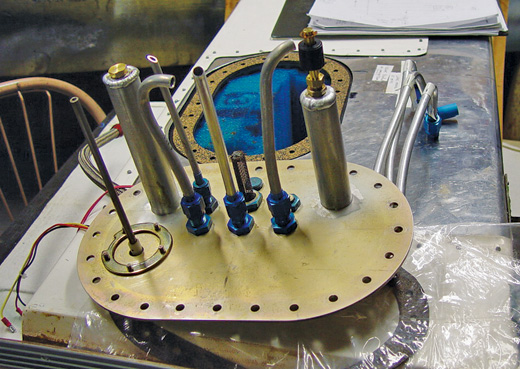
The float switch on the right tower replaces two infrared sensors that were supposed to control the transfer of each wing tank’s fuel and also stop pumping when the tank was empty. They didn’t work, but the switch works great.
Another original feature I questioned was the 11-gallon header tank that resides right over our legs, ahead of the panel. The tank is just the top of the fuselage’s thin forward fiberglass structure, screwed to the main fuselage. I did a study many years ago and found that about half the general aviation fatalities resulted from fires after survivable crash landings, a safety issue that has always bothered me. On my last Experimental, the Magnum V-8 Pickup, I designed a single gas tank that was instantly droppable. But that wasn’t possible in the Lancair, which has two auxiliary wing tanks feeding the main, the header. To me it looked ominous in the event of an otherwise-survivable crash, so I had a race-car-type bladder with crash-proof foam baffling made to fit inside the header tank to increase crash safety. I hope I never test it, but it did alleviate one back-of-the-mind worry.
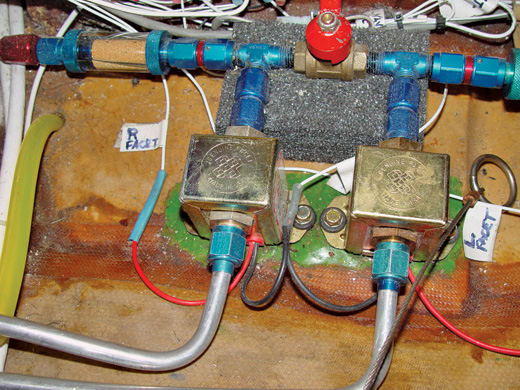
Auxiliary wing tanks transfer pumps and crossflow valves feed the main header tank.
Finally, to avoid possible pilot-error fuel mismanagement, I installed a no-management fuel-transfer system modification. Many Lancair builders modify the original plans to get the kind of system they are comfortable with, and I did, too.
Now the 100LL from the two 17-gallon auxiliary wing tanks flows through each tank’s transfer pump up into the 11-gallon header. The header outlet drains through the fuel shutoff and down through a large filter, through the boost pump, then to the engine-driven pump, past a total-fuel-used sensor, a fuel-pressure sensor, and then through another fine filter and into the Bendix fuel-injection servo, spider and finally to the injectors. The wing transfer pumps are always on unless a float switch in the header tank senses the header is full and interrupts the transfer pumps’ circuit. The float switch cycles the transfer pumps automatically. Each pump can also be turned off if necessary. For example, if one transfer pump should fail, there is a cross-flow connection between their outputs that can be opened to let the other pump feed the header from both wing tanks. A sight gauge was added to the header as redundancy for the fuel-used sensor. We fill up the wing tanks and fly like Cessnas.
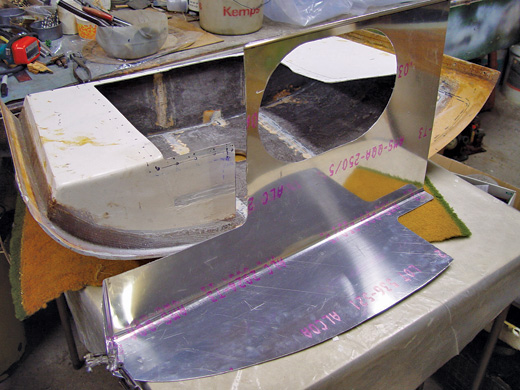
Gutting the header tank involved a lot of measuring, cold sweat and a lump in the throat, the author says, but the modification came out beautifully.
How It Aviates
For more engine reliability and efficiency we installed dual Light Speed Engineering ignition modules in place of the two Bendix mags, which gave a serendipity bonus by opening up more room between the engine and the firewall, something sorely needed in the Lancair. The LSE ignition switches are hot to the battery, as are the electric MT prop and the canopy actuator. The engine keeps going on battery, even with both alternators off.
One piloting problem remains: rudder trim. It’s less so after I added 2-plus inches to the rudder chord, but the Lancair design has a big P-factor. During takeoff or high-powered slow flight, I have to stand on the right rudder to center the ball until we get a little airspeed, though it flies “feet off” at cruise. I’m thinking about an electric anti-servo rudder trim—but after all the mod work I’ve done, not until we do some more cross-country flying. Being able to perform these mods myself and starting with a partially completed early Lancair kit, our investment to this point—engine, MT prop, glass panel and materials—amount to less than a Legacy bare airframe kit.
We will be flying over mountains in the future to visit three of our progeny, so we have also added oxygen behind the seat.
My copilot and I take off at 1650 pounds gross, climb full power to altitude, prop pitch back at cruise speed, lean the engine, follow the magenta course line on our GPS, click on the autopilot, and watch the clouds and the beautiful Earth slip by below.
With our Lancair, we can take quick and affordable trips to visit family and friends, in many cases with door-to-door times rivaling the airlines, and we don’t have to take off our shoes. We’re thankful that we were free to build this airplane ourselves and add little extras to make it safer. It makes traveling in it that much more enjoyable.
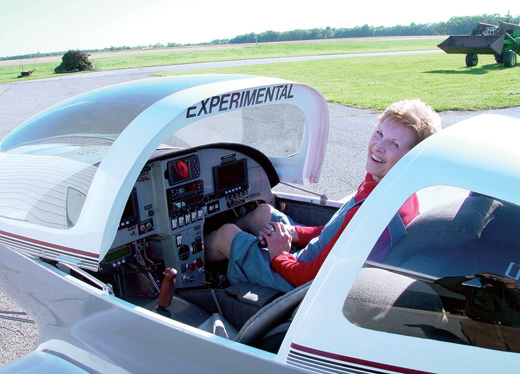
Co-owner/builder/pilot Cynthia in the magnificent flying machine.






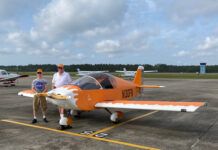
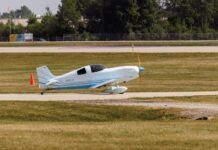
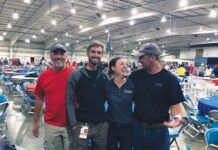
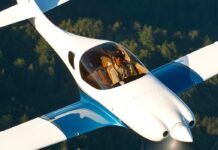

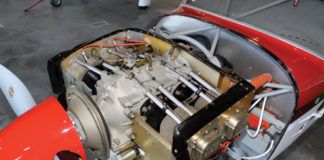
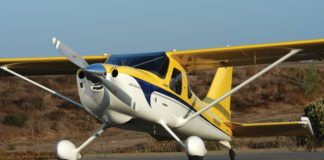
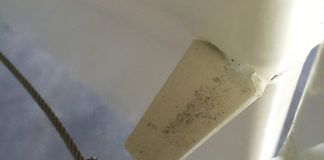
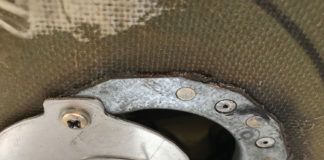
To the Author/Owner,
Very interesting mods you carried out. Did you consider wing tip extensions? I am keen to lower the stall speed to 45kts if possible on L320. The VGs seem like a great idea if they really work.
I am contemplating the purchase of a L320 thus the interest.
Is it possible to contact you re these mods?
Thank you.
Terrence,
Love all the mods you have done to your airplane! I would love to do the same mods to mine. Can you point me to more detailed instructions on how to do them?
Thanks,
Brian Rourke
As these other two pilots have asked, I too am interested in performing some of these modifications. Is it possible to acquire more details?
Many thanks!
Mark
Looks like this bird had a mishap a couple months after the article. Look up the tail number…
A right brake line failed, Aparently, after landing and as I was on both brakes, the left one took us into the sod infield which was very rough with a ditch, which totaled the place. I still regret not rebuilding it… but I was 85 then and didn’t want to spend time not flying… and other reasons.
hello
I do have a lancair 320 and wondering if you can help me shed some details with few of the modifications you made.
My email is [email protected]
thank you so much
I am now 92, and am working on my last designm, an electeric-powered fan-propelled BWB.
Sorry I do no lonbgerh have time to recall details of tghe p;ast, ut am tryng to show what can now be done for futgure Experimental pilots.
… to be contimnued, I hope….
Sorry for the typos.
Terrence